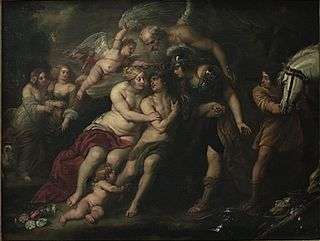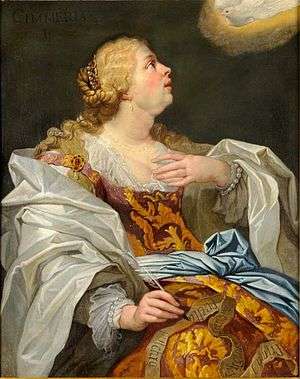Jan van den Hoecke

Jan van den Hoecke[1] (4 August 1611 – 1651) was a Flemish painter, draughtsman and designer of wall tapestries. He was one of the principal assistants in Rubens’ studio in the 1630s, later traveled to Italy where he resided for a decade and subsequently worked as a court painter in Vienna and Brussels.
Life
He was born in Antwerp in an artistic family. It is believed that, like his brother Robert van den Hoecke (1622–1668), he first apprenticed with his father, the painter Gaspar van den Hoecke (1595–1648). He then worked in the studio of Peter Paul Rubens in the 1630s.[2]

While he was at Rubens’ studio he was a frequent collaborator on various major projects of Rubens. He is believed to have collaborated with Rubens on the ceiling decorations for the Banqueting Hall.[3] Together with his father, Jan contributed to the decorations for the Joyous Entry of Cardinal-infant Ferdinand in Antwerp on 17 April 1635, the overall artistic design of which was under the direction of Rubens. Jan painted monumental representations for this occasion after designs by Rubens.[2] Of these large-scale works some have been preserved such as the Triumphal Entrance of Cardinal Prince Ferdinand of Spain (Uffizi Gallery) and The Battle of Nördlingen, 1634 (Royal Collection). It is known that the latter work, which celebrates the Cardinal-Infant’s victory over a Swedish army at the Battle of Nördlingen of 1634 was painted by van den Hoecke after an oil sketch by Rubens. It was placed at a central position in the centre of the front of the Arch of Ferdinand during the Joyous Entry. It remained outside for a few months after the event during which it was exposed to the natural elements. As van der Hoecke was in Italy by this time, Jacob Jordaens carried out some re-touching of the canvas in 1636 before it was offered to Cardinal-Infant Ferdinand in 1637.[4]
Jan van den Hoecke travelled to Italy where he resided likely from 1635 to 1644 although some extend the period of his stay to 1646.[5][3] In Italy he seems to have become familiar with the paintings of Guido Reni and studied the antique. These influences explain the classicizing trends in his later work.[6] In 1644, the artist was accepted in Rome as a member of a select club, the Virtuosi al Pantheon.[2]
Van den Hoecke moved to Austria and entered the service of Emperor Ferdinand III in 1644. He also painted for Ferdinand’s brother, Archduke Leopold Wilhelm of Austria (1614–1662), including a Madonna and Child and a number of allegorical pieces. Van den Hoecke returned to his home country with Archduke Leopold Wilhelm when the latter became the governor of the Southern Netherlands in 1647.[2][7] He was at the same time a court painter and the conservator of the art collection of the Archduke, which was reported to be one of the largest in Northern Europe and comprised about 1,400 paintings and other artworks.[3][7]
He died in Antwerp or Brussels.[5]
Work
General
Van den Hoecke was a versatile artist producing historical paintings as well as portraits and designs for tapestries. His work combined the achievements of the art of Rubens with 17th-century Italian Classicism.[2] The artist and his work have only started to attract renewed attention from art historians since the 1970s. A better understanding of the characteristics of his style have led to the re-attribution to van den Hoecke of works earlier given to other collaborators of Rubens such as Erasmus Quellinus II and Jan Boeckhorst and tentative attributions of work earlier given to Theodoor van Thulden. Conversely, the increased knowledge of his unique style has also led to the attribution to other painters of works earlier given to van den Hoecke.[3]

Style
His early style with its precise draughtsmanship and closeness to Rubens can be found in his oil sketch of The Triumph of David (Kimbell Art Museum) (1635) that was for a long time regarded as a work by Rubens.[6][8] His Hercules between Vice and Virtue (Uffizi Gallery) shows the influence from both Rubens (particularly Rubens' style between 1610-1620) and Anthony van Dyck. The closeness of his style to that of Rubens may have led to the attribution in 1780 to van den Hoecke of the Massacre of the Innocents (now attributed to Rubens) when it was in the Liechtenstein Collection.[9] Van den Hoecke painted a series of Sibyls which have been attributed to his earlier period from 1630 to 1637.[10]
The influence of Reni’s idealized figure types as well as of Domenichino and Poussin (see the Virtue Overcoming Avarice of 1637) are visible in the allegorical paintings he produced in Vienna. An example is the Virtue Overcoming Avarice in the Kunsthistorisches Museum. His familiarity with the work of Andrea Sacchi is reflected in his portraits of Emperor Ferdinand III and Archduke Leopold William. His style retained a certain reticence and a stiffness of composition as reflected in his Equestrian portrait of Archduke Leopold Wilhelm the static composition of which is clearly different from the lively equestrian portraits by Rubens and Anthony van Dyck.[6] A portrait of Ferdinand III (Kunsthistorisches Museum) painted at around 1643 shows the same unadorned and austere appearance and contrasts sharply with the glorious and militant portraits of the Flemish Baroque of the 1630s.[11]
Collaborations
As was common in the Flemish art scene at the time, van den Hoecke collaborated with other painters who were specialised in a particular genre. An example is the Amor vincit omnia (Kunsthistorisches Museum), in which the figure of Cupid was painted by van den Hoecke and the still life elements by Paul de Vos. It is not clear whether the composition is an allegory of peace, as suggested by the figure of Cupid and the traditional title, or rather an allegory of transience (vanities), as indicated by the motifs of the money bag, the armour and the musical instruments.[12]
There were 45 paintings of van den Hoecke in the Archduke's collection, which was the largest number of paintings of a Flemish artist in the collection. About half of these works found their way to the Kunsthistorisches Museum, Vienna as the collection was moved to Vienna when the Archduke returned to his home country. The large number of van den Hoecke paintings in the collection is probably due to the Archduke’s preference for the more classicistic style of van den Hoecke.[3][7] The Archduke also commissioned van den Hoecke to paint copies of Italian artists such as Titian and Veronese probably in order to complete the Archduke's collection of Venetian artists.[13]
Tapestry designs

For Archduke Leopold Wilhelm, van den Hoecke further designed the pattern boards for a series of 12 wall tapestries on the motif of vanitas and a series of ten tapestries under the title 'Allegory of Time' (c. 1650): Day and Night, six pictures of The Months, the Four Seasons, the Four Elements and the Triumph of Time. The series of the Allegory of Time was woven between 1647 and 1650 in the Brussels tapestry workshop of Everaert Leyniers III. Several other artists such as Pieter Thijs and Adriaen van Utrecht also worked on the series. Ten preparatory oil sketches that van den Hoecke made for the series have survived (four in the Kunsthistorisches Museum, Vienna), as have eight tapestries based on the designs for Day and Night and The Months. Four of the modelli for The Months are now in the Miramare Castle in Trieste.[6][14]
The cartoons of van Hoecke for the Allegory of Time series were innovative in that they dispensed with the traditional borders of the tapestries which he replaced by elements of the picture such as piers, entablature and foreground step of the architecture as well as with sumptuous festoons of game, fowl, fish, flowers and fruit. He was also able to create an illusion of three-dimensional space by extending the architectural elements behind and around the figures.The muted palette of the modelli shows that van den Hoecke was more interested in line and composition than in colour.[14]
References

- ↑ Alternative names: Johannes van den Hoecke, Jan van der Hoecke, Jan Van den Hoecke, Jan van Hoek, Jan van Hoeck, Jan Vanhoek, first name also 'Giovanni' in Italy
- 1 2 3 4 5 Matthias Depoorter, Jan van den Hoecke at Barok in Vlaanderen
- 1 2 3 4 5 Jahel Sanzsalazar, Jan van den Hoecke: quelques précisions et nouvelles propositions pour le catalogue de son oeuvre, in: Revue Belge d'Archéologie et d'Histoire de l'Art, Académie Royale d'Archéologie de Belgique / Belgish tijdschrift voor Oudheidkunde en Kunstgeschiedenis, Koninklijke Academie voor Oudheidkunde van België, LXXXII, 2013, pp. 45-78 (French)
- ↑ Jan van der Hoecke (Antwerp 1611 - Antwerp or Brussels 1651), The Battle of Nördlingen, 1634 at the Royal Collection
- 1 2 Jan van den Hoecke at the Netherlands Institute for Art History (Dutch)
- 1 2 3 4 Günther Heinz. "Hoecke, Jan van den." Grove Art Online. Oxford Art Online. Oxford University Press. Web. 17 Jul. 2014
- 1 2 3 Karl Schütz, Zeitgenössische niederländische Malerei in der Sammlung Erzherzog Leopold Wilhelms, in: De zeventiende eeuw. Jaargang 13. Uitgeverij Verloren, Hilversum 1997, p. 371-377 (German)
- ↑ Kimbell Art Museum, Triumph of David, image of work and background information
- ↑ Iain Robertson, The Art Business, Routledge, 28 Aug 2008, p. 41-42
- ↑ Jan van den Hoecke, Sibylla Cimmeria, 1630 at 1stdibs
- ↑ Dr Andrew H Weaver, 'Sacred Music as Public Image for Holy Roman Emperor Ferdinand III: Representing the Counter-Reformation Monarch at the End of the Thirty Years' War', Ashgate Publishing, Ltd., 28 Jan 2013, p. 34-35
- ↑ Karl Schütz, Zeitgenössische niederlandische Malerei in der Sammlung, in: Vrede van Munster, Katholieke Universiteit Nijmegen, Uitgeverij Verloren, 1997, p. 371-378
- ↑ Hans Vlieghe, Katlijne van der Stighelen, 'Sponsors of the past: Flemish art and patronage 1550-1700 : proceedings of the symposium organized at the Katholieke Universiteit Leuven, December, 14-15, 2001, Faculteit Letteren, Departement Archeologie, Kunstwetenschap en Musicologie,' Katholieke Universiteit te Leuven (1970- ) Brepols, 2005
- 1 2 Thomas P. Campbell, Pascal-François Bertrand, Jeri Bapasola, 'Tapestry in the Baroque: Threads of Splendor', Metropolitan Museum of Art, 1 Jan 2007
External links
![]() Media related to Jan van den Hoecke at Wikimedia Commons
Media related to Jan van den Hoecke at Wikimedia Commons